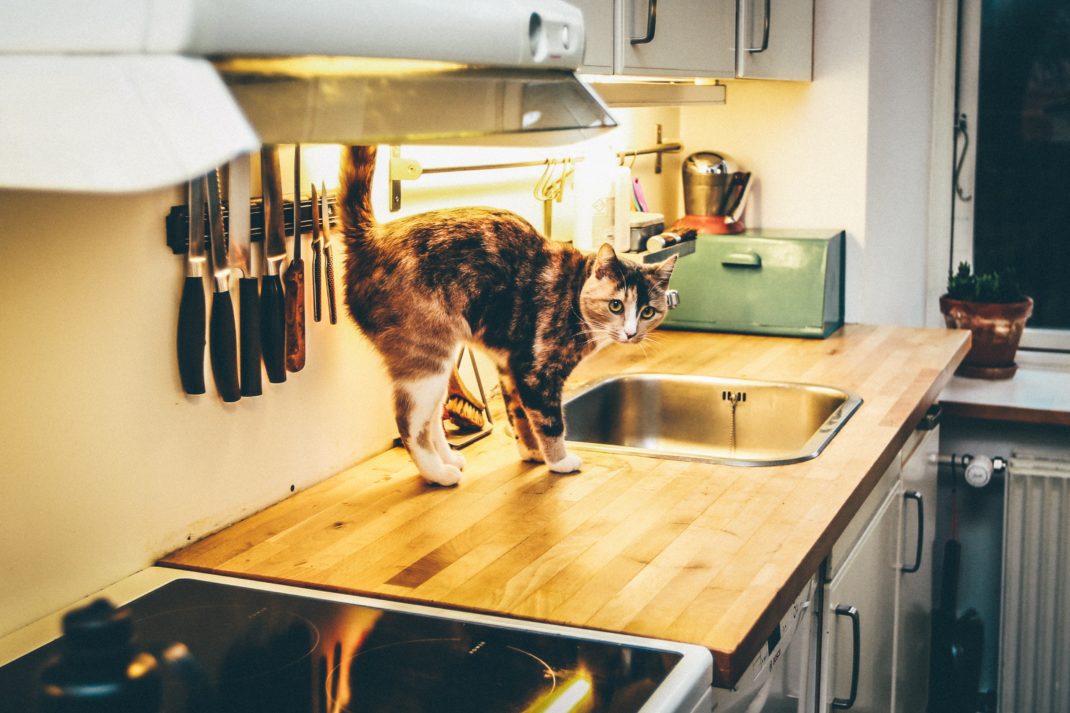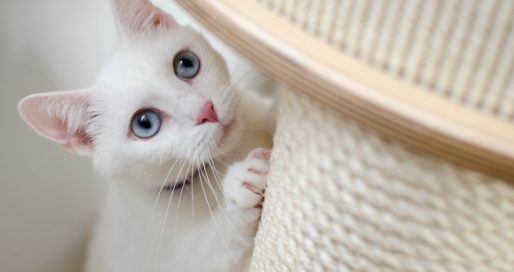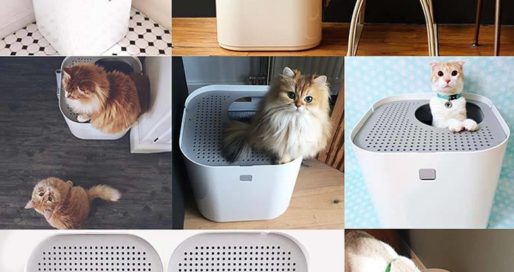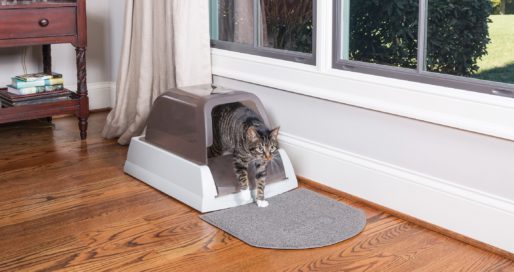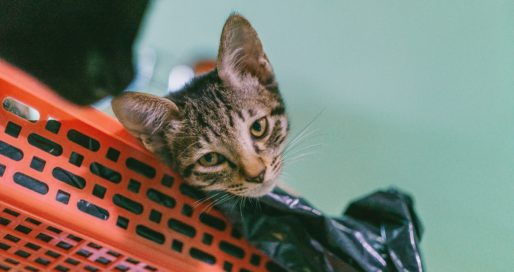It’s 6:30 PM. You’re grating some cheese to top off a nice fish stew that you’ve been working on for the past three hours. Your turn your back on your cooking for a second to check your recipe. When you get back, behold!
Your cat is up in your business, eating your fish and cheese! Drat!
But what do you do? How do you stop your cat from constantly ruining your fish and cheese dinners by jumping up onto your kitchen counters?
It may not hurt to consider just why it is your cat feels compelled to get onto your counter. Maybe your tasty-smelling chow was enough to entice him up there in this case. But there may be other times when you’ve found him on the counter, sunning himself or knocking around a salt shaker, seemingly with no motivation other than to get on your nerves.
Why Do Cats Jump on Counters?
Cats keep a short list of reasons for jumping up on kitchen counters written on a small piece of paper folded nicely and placed in their vest pocket. Unfortunately, most cats forget to wear their vest on a daily basis. The ones who remember to wear their vest typically have butlers that dry clean their clothing for them, so their owners never think to check the pocket for any secret lists. But we’ve managed to intercept a copy, and here it is.
Instinctual Love of Heights
By their very nature, cats are attracted to heights. They are natural born climbers, and if there’s something in your house that looks like it can be scaled, your cat is probably going to give it a shot. There’s not much you can do to stop them either.
A cat’s love of heights comes from the fact that he typically hunts for his food. A cat can survey a larger area if he’s perched up high than he can when he’s crouching in the tall grass. A high lookout post also prevents predators from attacking or sneaking up on a cat, keeping them safe. As a result, cats tend to seek out high spaces for the associated feeling of security they provide. Also, cats probably just like to feel superior to their human owners.
Interesting / Delicious Stuff
There are a lot of interesting items on your countertop, including food and small items that your cat would love to bat around. Delicious foods may be enough to tempt even the most well-behaved cat into jumping up onto your kitchen counter. There may be other items up there that are especially interesting to cats, including spice bottle, utensils, and other small things that a cat would love to bat around like an artificial mouse.
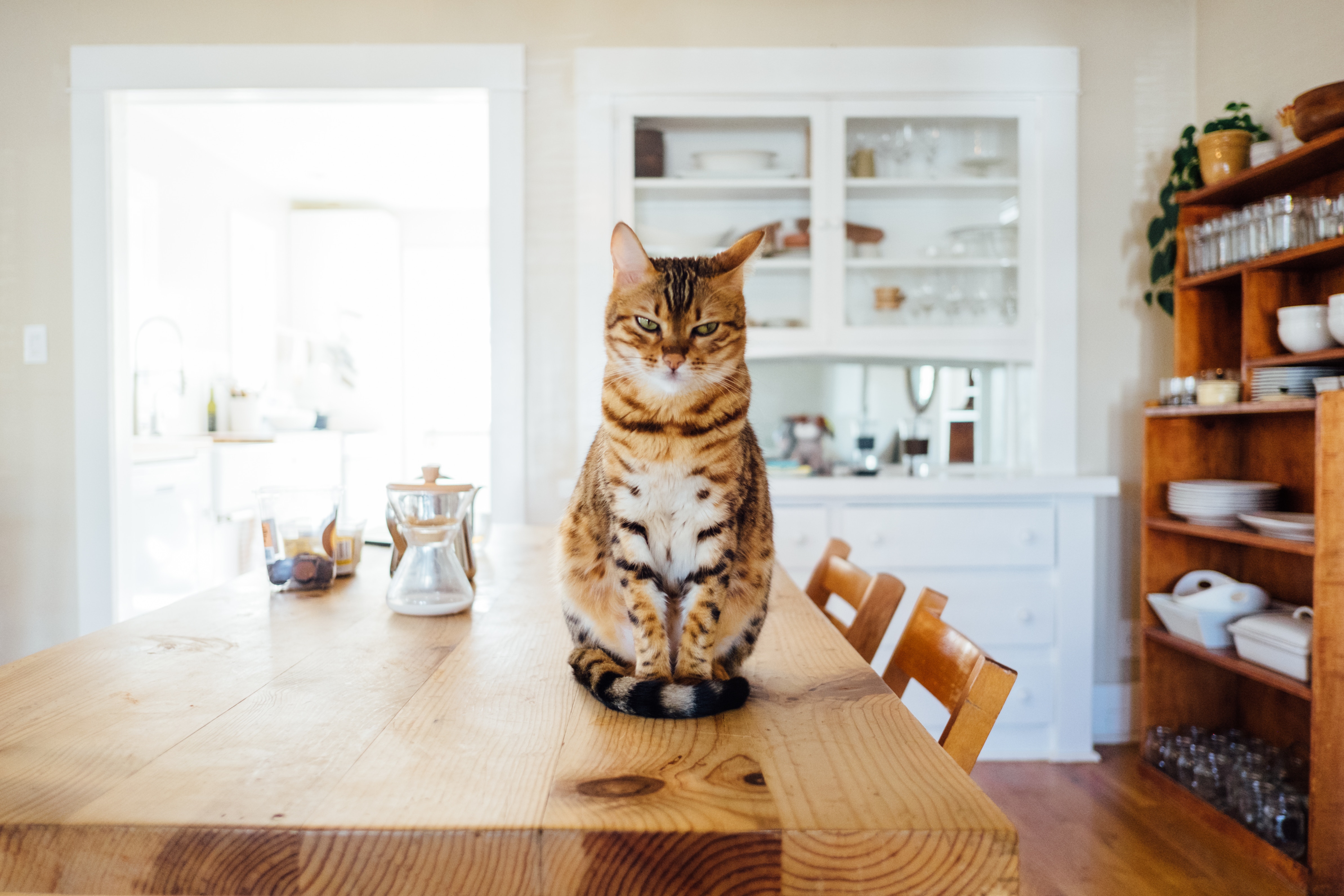
Access to Fresh Water
Cats love running water. In the wild, a cat would never drink out of a stagnant puddle formed in the mud. They would find a stream or spring, drinking from a source of running water.
While this may be simply because running water tastes better, it also serves to protect a cat’s health, as stagnant water is much more likely to contain bacteria or insects that may cause illness. This is why it’s so important to keep your cat’s water dish clean and to change the water regularly.
If your kitchen counter is connected to a sink, your cat is probably going to want to check that sink out. Whether he’s lapping up the remaining drops on the sink basin floor after you’ve just rinsed the dishes or drinking greedily from a leaking faucet, your cat is probably going to show your kitchen sink more interest than an ordinary bowl of stagnant water. And he’s going to need to hop up onto your kitchen counter to do it.
Boredom / Attention
Maybe your cat is just bored, so he’s jumping up onto the counter looking for excitement. This may be excitement in the form of exploring the countertop surfaces, or it may be excitement derived in the frantic response the jump elicits in you, the owner.
Cats can very easily confuse our responses to their unwanted behavior as invitations to play. Cats regularly play fight with one another, so for you to quickly pick a cat up and set them on the ground after they’ve jumped up onto the kitchen counter may be construed as a play fight initiation. Your cat may be jumping up on the counter to get you to pay attention to them or to play with them.
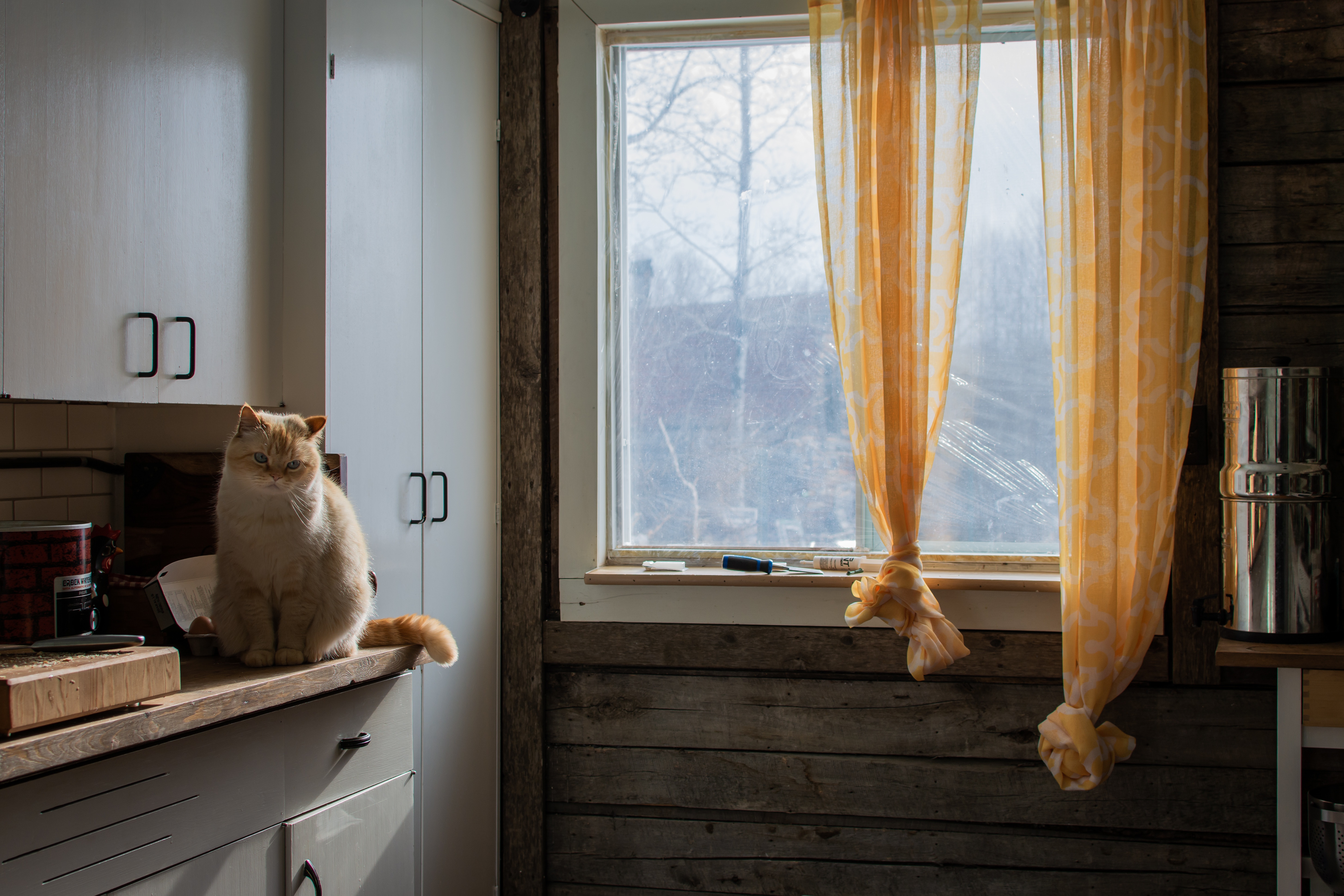
How Do I Keep My Cat off of the Counter?
Try the methods listed below the next time your cat gets in the way while you’re chopping up some salmon:
1. Start Early
Don’t let your cat get into the habit of getting onto the counter before working to correct the behavior. The sooner you choose to confront your cat about the situation, the easier it will be to correct the behavior. This means refusing to pet your cat or award them with affection whenever they jump onto the kitchen counter, no matter how difficult that may seem.
2. Keep Your Counters Clean
Don’t leave any spare food out on the counter. Make sure to put away any small objects, especially sharp knives that may potentially hurt your cat. If your counters are full of little trinkets and scraps of food, your cat may confuse these items for toys and snacks. But if your counters are empty, your cat will probably get bored with them pretty quickly.
3. Give Your Cat Climbing Alternatives
Cats are gonna climb, and there’s not much you can do to stop them. Why not give them something that they’re allowed to climb all over? Provide your cat with climbing alternatives such as cat trees and other types of cat furniture and he will be less interested in climbing onto your kitchen counters.
4. Use Commercial Repellants
There are a number of commercial repellents available that can be used to keep your cat out of areas where you don’t want him to be. These repellents can be useful if you have a particularly determined cat who is unfazed by some of the other methods proposed on this list.
Here are a couple of commercial repellents that work well for keeping cats off of kitchen counters:
PetSafe SSSCAT Spray Pet Deterrent
5. Evaluate Your Cat’s Feeding Schedule
Hungry cats are much more likely to show interest in the food on your counters, especially during meal preparation. If your cat tends to jump up on your counter while you’re preparing dinner, consider feeding your cat right before you start cooking. Your cat will be too distracted with his own meal to bother you while you prepare yours.
Once your cat finishes eating, he’ll probably groom himself and take a nap. This gives you plenty of time to finish fixing your meal without any interruptions from your cat.
6. Provide Sufficient Entertainment
Make sure your cat has plenty of toys and other things to keep him busy. Also, make sure you’re spending plenty of time playing with him. A cat that jumps up onto counters may just be looking for attention from you, or trying to get you to play with him. Try to beat him to the counter jump, playing with him beforehand and tiring him out so he’s less inclined to get onto your counters.
If your cat is not particularly interested in toys, consider getting him a food puzzle. If your cat is still interested in food that may be stored on your kitchen counter, a food puzzle may be enough to keep him entertained while resting on an acceptable surface, such as the floor.
7. Restrict Access
If your cat simply cannot resist the smell of food while you’re cooking, you may need keep him out of the kitchen during meal preparation. This may mean shutting the doors, or enclosing your cat in another room temporarily.
Once you have finished your work in the kitchen and cleaned off your counters, you can let your cat back in. If your cat is only interested in your food, then he should have lost interest in the kitchen counters once the food has been put away.
8. Use Positive Reinforcement
Reward your cat whenever you observe him jumping up onto cat furniture in lieu of the kitchen counters. Use treats and affection, giving your cat plenty of pets. Your cat will begin to associate his behavior with treats and will do it automatically, abandoning his previous fascination with your countertops.
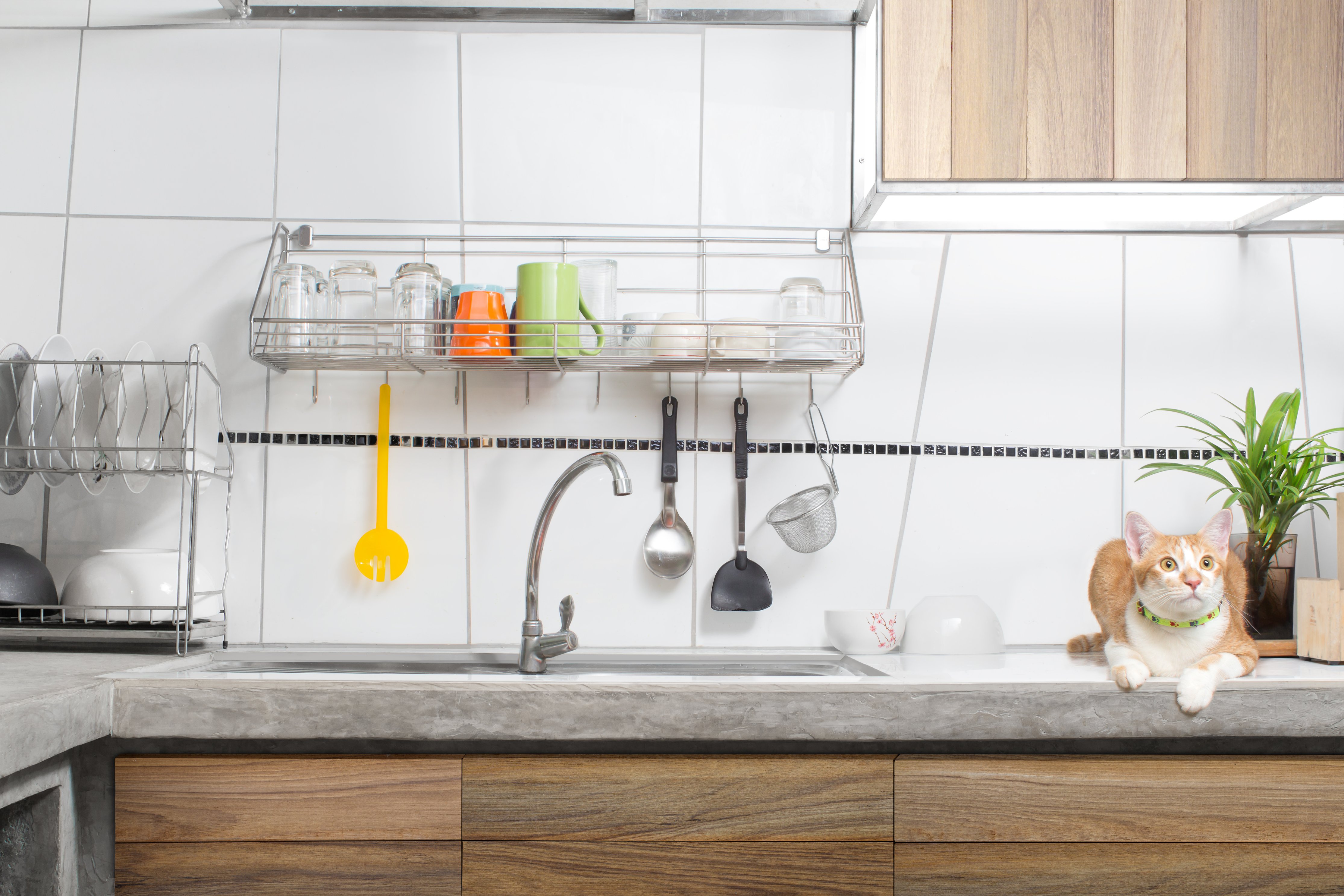
White kitchen sink interior
9. Modify the Counter Surface
Modify the surface of the counter using a material that your cat hates to walk on. Examples including aluminum foil, double-sided tape, or plastic matting. Ideally, the surface should be modified as close to the counter edge as possible. This way the modified surface is the first thing your cat comes into contact with when he tries to jump onto the counter. If he dislikes the surface, he will jump down immediately.
Aluminum foil is a good option since it is cheap and accessible, but it doesn’t look very nice. Plastic mats work well since they are easily cleanable and are less ugly than aluminum foil. Double-sided tape placed on the outer perimeter of the counter also works well, but make sure to choose a brand that won’t leave a residue and won’t tear off part of your counter. You may want to test out the tape on a part of the counter that is not usually visible before using the tape across the entire countertop.
10. Don’t Resort to Punishment
Don’t try to punish your cat. Negative reinforcement is not an effective training method. Avoid using a spray bottle, yelling at your cat, or tossing your cat off the counter angrily. All of these things will just scare and confuse your cat, and they will not address the behavior effectively.

